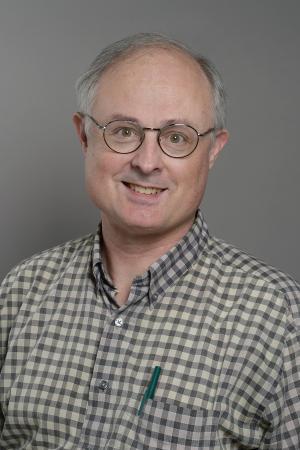Professor Ashbaugh has been actively involved in teaching and research in mathematics since he earned his Ph.D. in 1980. He has coached the MU Putnam team on numerous occasions. The 2012 team achieved MU's highest ranking ever on the Putnam, ranking 18th among the 578 participating institutions. His most significant honors include being elected to the Chilean Academy of Sciences in 2009, being named Leonard M. Blumenthal Distinguished Professor of Mathematics for 1997-2002, receiving the 1992 Chancellor's Award for Outstanding Faculty Research and Creative Activity in the Physical and Mathematical Sciences, and being named Luther Marion Defoe Distinguished Professor of Mathematics for 1991-96. Professor Ashbaugh also served as the Chair of the Mathematics Department for 2002-2008, and was a Fulbright Fellow at the Pontificia Universidad Catolica de Chile in Santiago, Chile, in Fall, 2009.
Professor Ashbaugh's research has been supported over the years by multiple NSF grants, and also by fellowships and research leaves from the Fulbright Foundation, the MU Research Council, and various conferences and lecture series. He has visited for extended periods at many universities and research institutes around the world.
Education
1980 Ph.D., Physics (Mathematical Physics), Princeton University, Princeton, New Jersey
1977 M.A., Physics, Princeton University, Princeton, New Jersey
1975 B.A., Mathematics and Physics, with Honors in each, Grinnell College, Grinnell, Iowa
Frequently Taught Courses
MATH 4100/7100, Differential Equations
MATH 4500/7500, Applied Analysis
MATH 4980, Mathematics Problems Solving
Research Interests
Broadly speaking, Professor Ashbaugh’ s research interests are in the fields of Differential Equations and Mathematical Physics, particularly Spectral Theory. Throughout his career his main research focus has been on the spectral theory of differential operators, especially the Schroedinger and Laplace operators. In recent years, he has also considered problems involving the bi-harmonic operator which arise in the study of the vibration or buckling of plates. Often his results have a distinct geometric flavor, wherein the result shows how geometry influences eigenvalues. For example, the Rayleigh-Faber-Krahn inequality tells us that the first Dirichlet eigenvalue of the Laplacian on an arbitrary domain can never be lower than that of the disk/ball of the same area/volume (in Euclidean space of the same dimension). In a similar way, the Ashbaugh-Benguria inequality (Payne-Polya-Weinberger conjecture) shows that the ratio of the first two eigenvalues of the Dirichlet Laplacian on an arbitrary domain can never be higher than that of the disk/ball in Euclidean space of the same dimension.
MathSciNet Links
authored by Mark Ashbaugh
Select Publications
Spectral Theory for Perturbed Krein Laplacians on Nonsmooth Domains (with Fritz Gesztesy, Marius Mitrea, and Gerald Teschl), Adv. Math. 223 (2010), 1372-1467.
The Universal Eigenvalue Bounds of Payne-Polya-Weinberger, Hile-Protter, and H. C. Yang, Special issue on Spectral and Inverse Spectral Theory (Goa, 2000), Proc. Indian Acad. Sci. Math. Sci. 112 (2002), 3-30.
A Sharp Bound for the Ratio of the First Two Dirichlet Eigenvalues of a Domain in a Hemisphere of S^n (with Rafael Benguria), Trans. Amer. Math. Soc. 353 (2001), 1055-1087.
Isoperimetric and Universal Inequalities for Eigenvalues, Spectral Theory and Geometry (Edinburgh 1998), E. B. Davies and Y. Safarov, editors, London Math. Soc. Lecture Note Ser., vol. 273, Cambridge University Press, Cambridge, 1999, pp. 95-139.
On Rayleigh's Conjecture for the Clamped Plate and its Generalization to Three Dimensions (with Rafael Benguria), Duke Math. J. 78 (1995), 1-17.
Sharp Upper Bound to the First Nonzero Neumann Eigenvalue for Bounded Domains in Spaces of Constant Curvature (with Rafael Benguria), J. London Math. Soc. (2) 52 (1995), 402-416.
A Sharp Bound for the Ratio of the First Two Eigenvalues of Dirichlet Laplacians and Extensions (with Rafael Benguria), Annals ofMath. 135 (1992), 601--628 (the main results of this paper were announced in ``Proof of the Payne-Polya-Weinberger Conjecture'' (with Rafael Benguria), Bull. Amer. Math. Soc. 25 (1991), 19-290.)
